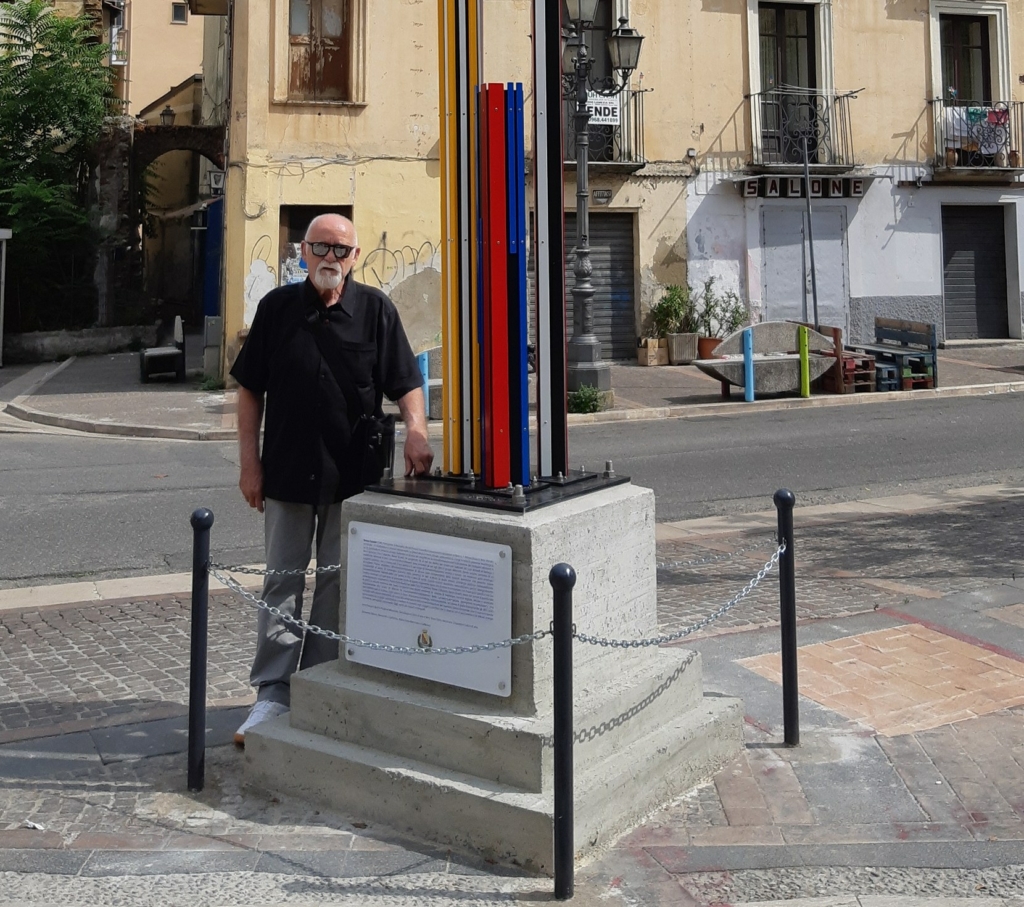
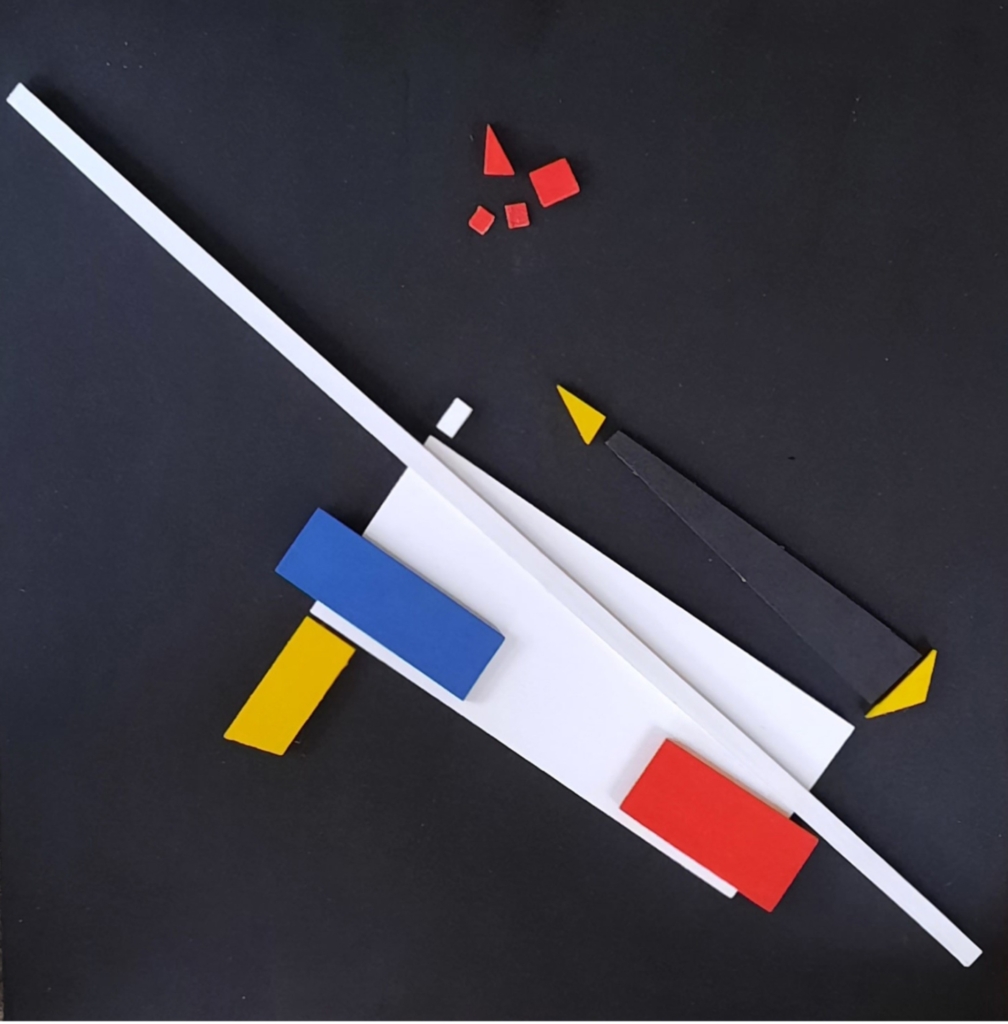
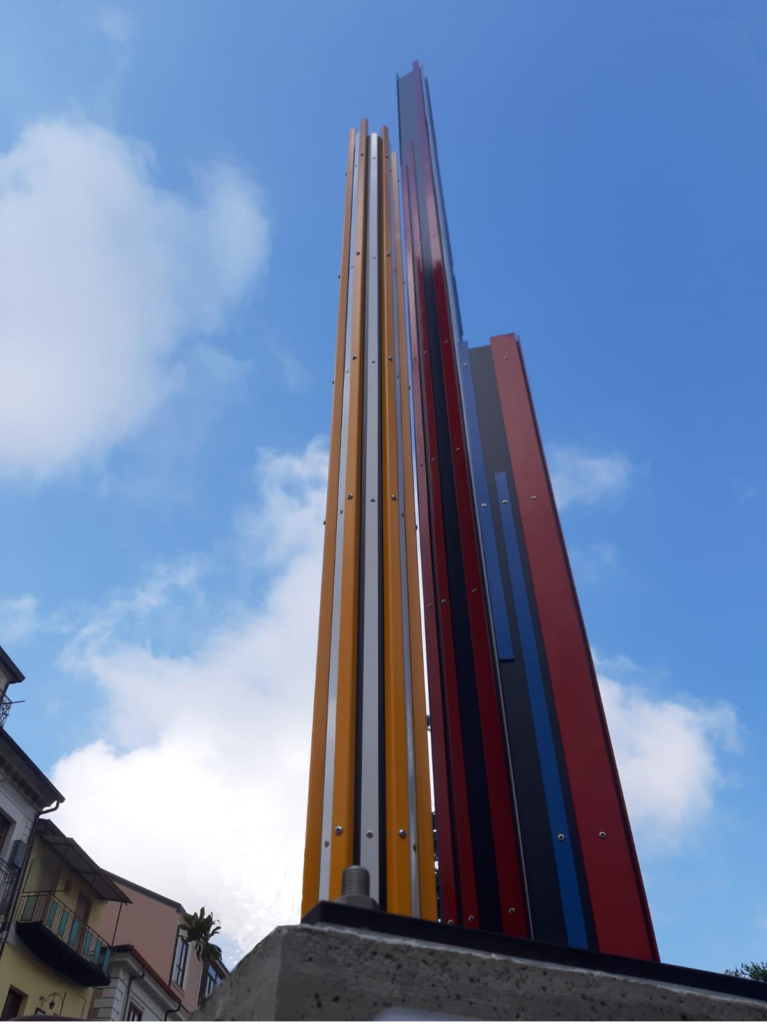
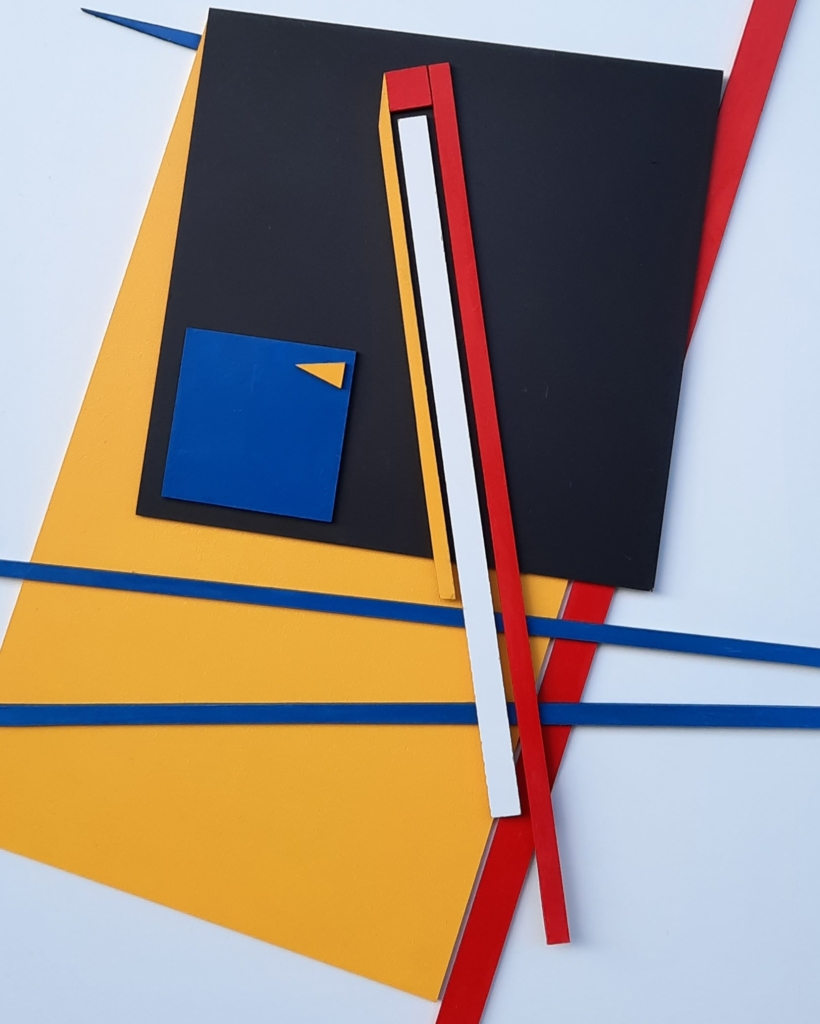
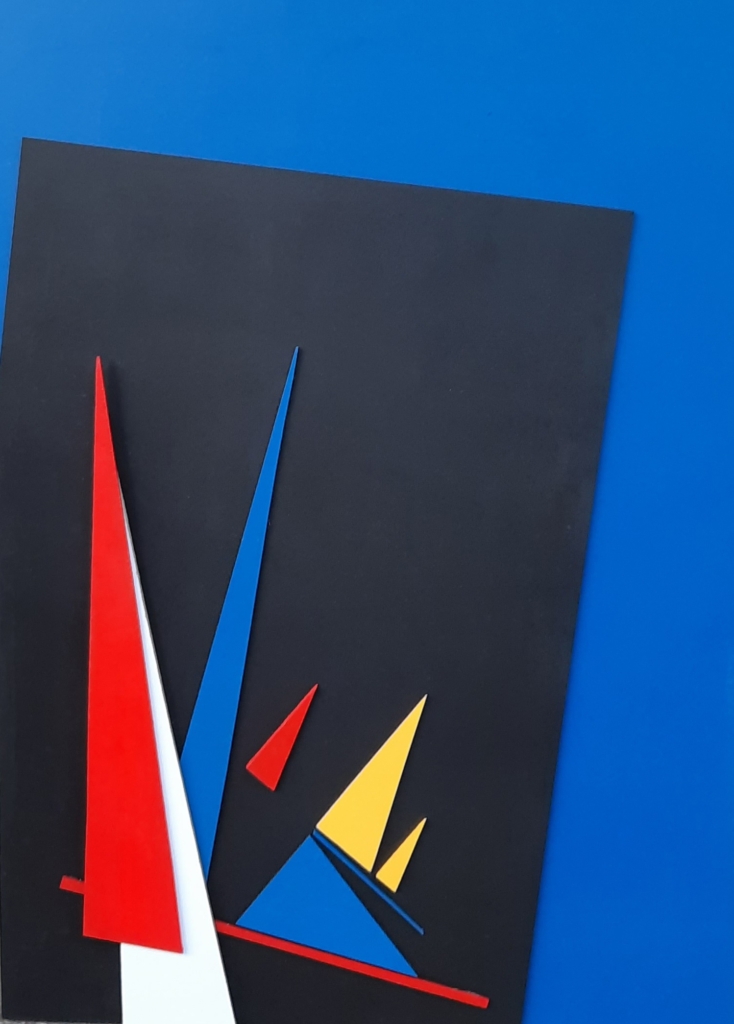
 È recentemente stato protagonista di tre mostre personali presso importanti musei di Rio de Janeiro, poi in un altro a Lamezia Terme il cui Comune ha anche acquisito una sua opera monumentale, e infine sta per uscire un romanzo-catalogo sulla sua vita. Ci dia qualche anticipazione del romanzo e dei suoi prossimi progetti.
È già da qualche anno che i miei figli mi esortano a lasciare qualcosa di scritto sulla mia vita movimentatissima, ricca di emozioni, di fatti piacevoli e, a volte, spiacevoli, accadimenti personali, amori, rinunce e gioie, ma costantemente con l’arte nel cuore, la mia musa, la mia amante, il mio tutto. Senz’altro l’impegno convinto e costante nell’arte mi ha fatto abbandonare mari calmi, sicuri, per addentrarmi in oceani tempestosi, mi ha travolto come un fiume in piena, ma non mi ha mai abbandonato. Dunque il romanzo parlerà di questo e di molto di più. Dal punto di vista espositivo sono in procinto di realizzare altre mostre importanti Brasile, esposizioni itineranti in altrettanti musei ancora in fase di definizione.
In cantiere, vorrei mettere anche la mia presenza in qualche fiera internazionale come Basilea in Svizzera, New York in USA, Gent in Belgio, dove ho già esposto tanti anni fa. Mostre frequentate dai più grossi collezionisti di arte moderna contemporanea.
RENZO EUSEBI-CONTATTI
Email: info2014@renzoeusebi.com
Sito web: http://www.renzoeusebi.com/
Facebook: https://www.facebook.com/renzoeusebi.eusebi
Instagram: https://www.instagram.com/renzoeusebi/
È recentemente stato protagonista di tre mostre personali presso importanti musei di Rio de Janeiro, poi in un altro a Lamezia Terme il cui Comune ha anche acquisito una sua opera monumentale, e infine sta per uscire un romanzo-catalogo sulla sua vita. Ci dia qualche anticipazione del romanzo e dei suoi prossimi progetti.
È già da qualche anno che i miei figli mi esortano a lasciare qualcosa di scritto sulla mia vita movimentatissima, ricca di emozioni, di fatti piacevoli e, a volte, spiacevoli, accadimenti personali, amori, rinunce e gioie, ma costantemente con l’arte nel cuore, la mia musa, la mia amante, il mio tutto. Senz’altro l’impegno convinto e costante nell’arte mi ha fatto abbandonare mari calmi, sicuri, per addentrarmi in oceani tempestosi, mi ha travolto come un fiume in piena, ma non mi ha mai abbandonato. Dunque il romanzo parlerà di questo e di molto di più. Dal punto di vista espositivo sono in procinto di realizzare altre mostre importanti Brasile, esposizioni itineranti in altrettanti musei ancora in fase di definizione.
In cantiere, vorrei mettere anche la mia presenza in qualche fiera internazionale come Basilea in Svizzera, New York in USA, Gent in Belgio, dove ho già esposto tanti anni fa. Mostre frequentate dai più grossi collezionisti di arte moderna contemporanea.
RENZO EUSEBI-CONTATTI
Email: info2014@renzoeusebi.com
Sito web: http://www.renzoeusebi.com/
Facebook: https://www.facebook.com/renzoeusebi.eusebi
Instagram: https://www.instagram.com/renzoeusebi/
Marta Lock’s interviews:
Renzo Eusebi, the unstable and tortuous road to artistic success
It is often said that making art today is not easy, because there are so many good creatives and because it takes effort to emerge, is needed a lot of self-confidence and time as well as money; but even in the 20th century, despite a completely different system, it was complex and involved a series of pitfalls and difficulties that made the path hard. Renzo Eusebi is an artist, now well established and included in the world’s most important museum libraries, who has developed his career at the turn of the century, taking his first steps around the middle of the twentieth century and then continuing to the present day, when he finally manages to see the realisation of an achievement in which he has always believed, with an unshakeable faith in virtue of which he has never given up, despite the objective difficulties, personal vicissitudes as well as the disappointments and disillusionments he has received from the art world. What has never failed, despite the transfers, professional changes and personal revolutions, has been his great love for art, which has allowed his style to evolve thanks to his innate creativity, the need to experiment and measure himself against ever new challenges to the point of achieving not only a unique language but also recognition in Italy and abroad, thus reaping precisely in the complex contemporaneity the fruits he has sown over many years by choosing to invest in himself, to believe in his abilities and to rely on important people who have helped him build his career step by step consolidating it over the course of the time. Reaching what is his current artistic style required a series of gradual steps that Eusebi has always listened to and followed whenever his instinct suggested to him, thus without fossilizing himself on a known and usual terrain but rather putting himself into play, following that impulse. inexplicable that, however, has always led him towards an evolution in step with the times and earned him international recognition for the originality of his work. Determination has been fundamental in overcoming those obstacles that would have sent many people into a panic, but for him they have always been a stimulus to overcome them, to seek a way and above all a reason to continue along that tortuous road; and the result today is the satisfaction of exhibiting in museums of great importance, of seeing some sculptures installed in the squares of Italian towns and, above all, of understanding that all the previous path was functional to reaching where he is today. His current style is a Geometric Abstractionism in which the colours are the primary ones used in De Stijl, even if the white background is not as rigidly essential as in Piet Mondrian’s artworks, while the figures accepted are not just squares and rectangles but open up to diagonals, triangles and the irregularity of material intersections such as enamels and faesite, which mix the Geometric Abstractionism that followed the first neo-Plasticist theories with a Material Informalism that nevertheless always adheres to the rigour of visual order. Yet at times Renzo Eusebi’s artworks appear unbalanced, as if the apparent schematisation were highlighted in order to be subverted, just as in fact happens in reality; work No. 17 therefore presents that sense of restlessness of the lines, as if in a few moments they should break down and then generate a new order, thus becoming a metaphor for the events of existence that occur to induce the individual to evolve and not settle into a comfort zone that often becomes immobilising. But then, when he has to reach upwards, it is good that all the forces in the field come together to achieve the distant goal that man has always set himself, that ascent towards the sky that can constitute the realisation of a dream; the monumental sculpture Cromoformesuonoverticalizzazioni, acquired by the Municipality of Lamezia Terme and installed in Piazza Bovio, represents an exhortation for the observer, a way to understand that despite the diversity, of emotions or more generally of people, represented by the different colours but placed next to each other, the most important result can only be achieved by uniting, fighting for the same ideal, gathering the fragments of experiences to build a stronger personality. Let us now get to know this great artist better. Renzo, you began your artistic journey in the 20th century, when everything seemed to be simpler than it is today. Do you think this theory is true, or did artists in the last century also have to overcome many obstacles? Can you explain the difference between the 20th and 21st centuries in the complex world of art? Without a doubt, in the last century, there were many more emblazoned art galleries with a consistent militancy, credibility and reliability in the field of art, which had a strong influence on the collectors of the time and were willing to buy artworks and resell them. Today, however, the artist has to be his own manager and therefore has to spend out of his own pocket, hoping that sooner or later someone will notice him. Towards the middle of the last century, the greatest incentive to buy an artwork was due to the new post-war situation and consequently people were more open to new experiences and knowledge. There was not all the media of today, and those who loved art or devoted themselves to it had to keep up to date by visiting galleries, museums and exhibitions, coming into tactile as well as visual contact with the work itself. Personally, having studied and lived in Rome in the 1960s, I noticed the strong economic recovery due to reconstruction, the joy of living and spending money to buy a Vespa, Lambretta, Fiat 500, TV or refrigerator, and in addition to these consumer goods, people felt the need to buy a painting to hang in the dining room. There were certainly obstacles in the last century, as there are now and will always be. Today, everything seems simpler, but there is a lot of confusion. You have participated in many art fairs abroad, how much have these experiences enriched you creatively? And how important is the comparison with a worldwide art scene? In the more than thirty-five international fairs in which I have participated since the 1980s, each time has been a growth and an awareness for me. Moreover, being able to show my artworks in the presence of the world’s most important galleries, exhibiting works by the greatest artists of modern art, both living and non-living, including talented emerging artists seeking fame and a thriving market, has been a major boost to my career and a great honour for me. To rub shoulders with the world’s leading artists is a continuous enrichment both spiritually and stylistically. One of the most significant opportunities in your journey over the last century was your membership of two art groups which, although in different ways, constituted a very important milestone. Can you briefly tell us about the good and the bad of having this kind of experience? I considered it right, stimulating and very formative to found, together with other artists, first Transvisionism-Beyond the Real and then, thanks to the idea and organisational drive of the art critic and historian Giorgio di Genova, the G.A.D. Gruppo Aniconismo Dialettico. Both were very important experiences. Constantly comparing oneself both artistically and philosophically helps one grow a lot and lays bare one’s soul and essence. The worst thing is that, at times, a sense of dominance sets in among fellow travellers, of wanting to be superior to others. This, unfortunately, leads to the disintegration of the movements themselves, thus confirming the theory of homo hominis lupus elaborated by Plautus. Let us talk about your painting style: you started with figurative art and then gradually moved on to Surrealism and finally to Abstractionism. Did these transformations go hand in hand with the evolution of your life and personal events, or were they the result of meditation, of a voluntary and rational choice? In my very long, demanding and tortuous artistic career, I have gone through and revised five movements that were very important for my artistic and expressive growth. Everything is due to the various states of mind I have gone through during the vicissitudes of my life. The most important thing is to always believe in what you are willing to change, sometimes even making a clean break without any remorse. I arrived at absolute Geometric Abstractionism after long reflections with myself, after abandoning the monochromatic period and rediscovering the primary colours that I had already used in the 1960s, my Fauves phase, and in the 1980s, my surrealist-abstract period. For some time I also studied the artists of the Bauhaus, a movement born in Weimar, Germany in 1919, headed by Walter Gropius. You have recently been the protagonist of three personal exhibitions in important museums in Rio de Janeiro, then in another one in Lamezia Terme, where the municipality also bought one of your monumental works, and finally, a novel-catalogue on your life is about to be published. Give us some anticipation of the novel and your next projects. For some years now, my children have been urging me to leave something written about my very eventful life, full of emotions, pleasant and sometimes unpleasant events, personal happenings, loves, renunciations and joys, but always with art in my heart, my muse, my lover, my everything. Without a doubt, my convinced and constant commitment to art has made me leave calm, safe seas to enter stormy oceans, it has swept me away like a river in flood, but it has never abandoned me. So the novel will be about this and much more. About exhibitions, I am in the process of creating other important displays in Brazil, travelling exhibitions in as many museums, which are still being defined. In the pipeline, I would also like to be present at some international fairs such as Basel in Switzerland, New York in the USA, Ghent in Belgium, where I exhibited many years ago. Exhibitions attended by the biggest collectors of contemporary modern art.